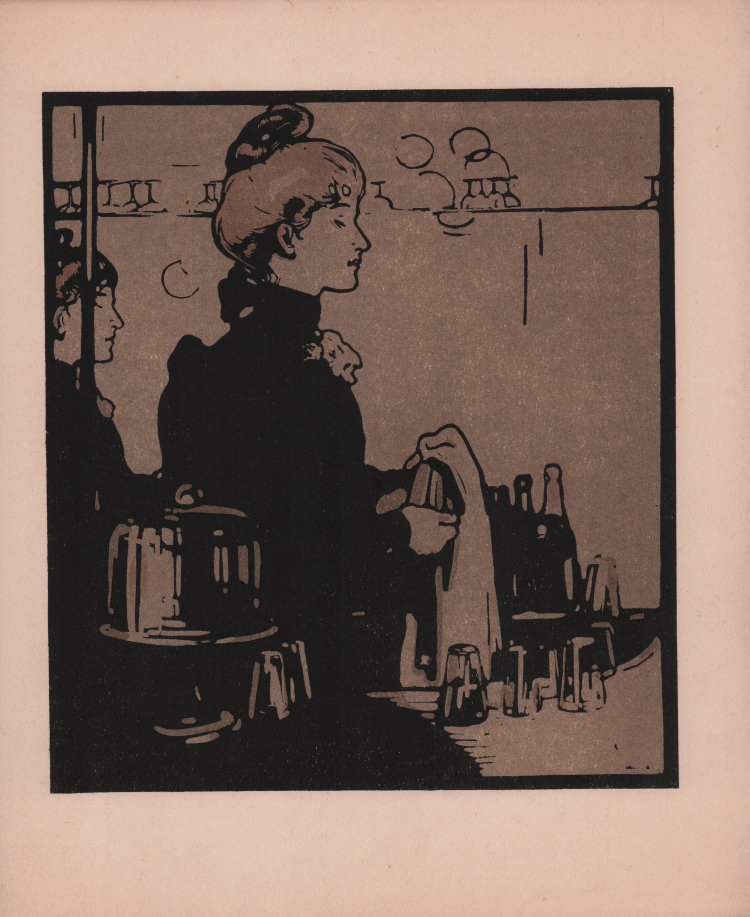



| Reference: | S44730 |
| Author | William Nicholson |
| Year: | 1898 |
| Measures: | 225 x 255 mm |


| Reference: | S44730 |
| Author | William Nicholson |
| Year: | 1898 |
| Measures: | 225 x 255 mm |
Standing behind the bar in profile, with high-necked dress, polishing a glass. Hand-coloured woodcut, 1898, printed on a cream board.
From a series of thirteen plates published by William Heinemann, London, in November 1898.
William Nicholson created his London Types in 1898. They were a set of images that, alongside his Almanac of Twelve Sports and An Illustrated Alphabet, were to make his reputation as a printmaker.
Working within the culture of the British popular print, Nicholson deliberately chose to use the coarse-grained side of the block in his wood cuts. This was a style that owed more to Toulouse Lautrec and Japanese precedents than to native visual traditions, which gave his work an innovative quality, even as he appeared to be celebrating traditional roles in British society.
Although not strictly Cries of London, some of these street characters are familiar from prints stretching back through the previous century and Nicholson portrays them as curiosities from another age.
William Nicholson’s London Types provide a distinctive contribution to the innumerable series of images that have portrayed street life throughout the centuries, remarkable both for their superlative graphic elegance and as a complex and witty social portrait of London at the dawn of the twentieth century.
Bibliografia
Campbell 1992, William Nicholson, the graphic work (53).
|
English artist well known for his unique style of woodcut prints. Beginning in the 1890s, he created posters with his brother-in-law James Pryde, using the pseudonyms J. & W. Beggarstaff. In 1897, Nicholson produced a woodcut print of Queen Victoria that was very well received and helped establish his reputation with the British public. About that same time Nicholson cut a series of wood blocks of An Illustrated Alphabet for publisher William Heinemann. Originally issued in a very small run of hand colored woodcuts, their popularity led to the images being transferred to lithographic stones and printed in a bound volume. This was soon followed by two other similar series of images, An Almanac of Twelve Sports and London Types. Nicholson's style is instantly recognizable, with the broad strokes from his original woodcuts printed with subtle variations of earth tones, harking back to earlier British chap book illustrations. After the turn of the century, Nicholson turned more to painting, though he did continue to produce illustrations for several books. The prints from his three bound plates volumes offer a wonderful sample of Nicholson's vision and also of British culture at the end of the nineteenth century.
|
|
English artist well known for his unique style of woodcut prints. Beginning in the 1890s, he created posters with his brother-in-law James Pryde, using the pseudonyms J. & W. Beggarstaff. In 1897, Nicholson produced a woodcut print of Queen Victoria that was very well received and helped establish his reputation with the British public. About that same time Nicholson cut a series of wood blocks of An Illustrated Alphabet for publisher William Heinemann. Originally issued in a very small run of hand colored woodcuts, their popularity led to the images being transferred to lithographic stones and printed in a bound volume. This was soon followed by two other similar series of images, An Almanac of Twelve Sports and London Types. Nicholson's style is instantly recognizable, with the broad strokes from his original woodcuts printed with subtle variations of earth tones, harking back to earlier British chap book illustrations. After the turn of the century, Nicholson turned more to painting, though he did continue to produce illustrations for several books. The prints from his three bound plates volumes offer a wonderful sample of Nicholson's vision and also of British culture at the end of the nineteenth century.
|